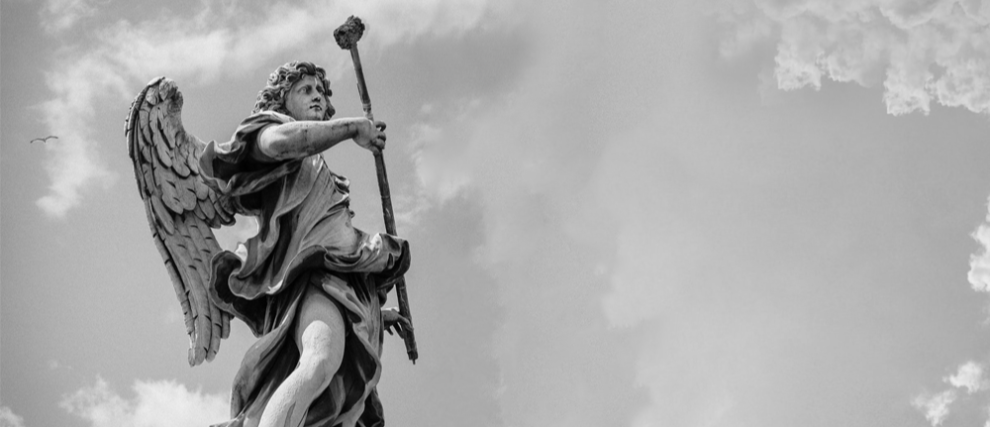Saint Benedict
Benedict was born in Nursia in the province of Umbria, Italy in 480, with his twin sister, who later became saint Scholastica. Born to an aristocratic family of the Anicia people, he was sent to study in Rome, where corruption disgusted him.
At the age of fifteen, he decided to leave Rome to seek God, the only one necessary, and to move away from this world of sin. With his nurse, he left for Affile where he performed his first miracle, which earned him his fame. For this reason, he continued his journey, meeting a Roman monk who guided him to eremite ife. He settled on the mountain of Taleo, in a cave, and then experienced a spiritual struggle, struck by loneliness and temptations. After that, he experienced the divine providence that does not abandon those who rely on it. Having become known around him, people came from all over to be enlightened by him. Benedict then decided to leave his life as a hermit to live in a community. Some monks asked Benedict to become their superior, but soon after tried to poison him. He preferred to return to his loneliness under the gaze of God.
Later, the hermit saw the disciples flocking in large numbers, and again left his hermitage to establish communities in the Aniene valley. Benedict founded thirteen monastic communities, including the monasteries of Subiaco and Monte Cassino (Mount Cassin Abbey). He proved to be endowed with a gift of discernment, knowing how to distinguish what comes from man, from God or from the Devil.
Around 540, Benedict wrote a Rule of Life for his communities, which is summed up by this famous motto: Ora et Labora (Prayer and Work). Benedict died in 549, he is celebrated on July 11.
The legacy of Saint Benedict
It was Pope Saint Gregory the Great, a monk at Saint Andrew's Abbey in Rome, who wrote about the life of Saint Benedict in 593-594, about 30 years after his death. In this book entitled Dialogues, he presents Saint Benedict as a model of holiness, recounting the miracles of the saint. Through this work, Saint Gregory made known not only the life but also the Rule of Saint Benedict. This rule was taken as the basis of religious life, which had hitherto been poorly organized. During the 8th and 9th centuries, Charlemagne imposed the Rule of Saint Benedict on his entire Empire, thereby creating a source of unity for medieval Europe. Through the network of monasteries, cultural connections were established between all parts of the continent, creating a European cultural identity. It is for this reason that Saint Benedict was proclaimed patron saint of Europe in 1964 by Paul VI.
The work of Saint Benedict of Nursia: the Benedictines
The rule of Saint Benedict is also the rule of the Cistercians and Trappists. In the 11th century, the Benedictine order was reformed and gave birth to the Cistercian order. Subsequently, Saint Bernard of Clairvaux gave the order immense influence.
After the crisis of the tenth century, religious life in the eleventh and twelfth centuries experienced a considerable boom and an exceptional period of fertility. It was the time of the foundation of the premonstrations with Saint Norbert, of the Franciscans and the Clares with Saint Francis of Assisi and Saint Clare, of the Dominicans with Saint Dominic, of the Carthusians with Saint Bruno and of the Carmelites. All these orders still exist and are still flourishing. As for the Benedictine order, it has spread to all continents and today represents a monastic reality established throughout the world.
The Medal of Saint Benedict
The medal of Saint Benedict is a very ancient gift of God. It is a sacramental object recognized by the Catholic Church and endowed with a great power of exorcism and liberation from demonic influences. Its power lies in Christ himself, who gave the medal to the Church, and it is by faith in Jesus that the medal can act. Until 1647, the full meaning of the inscriptions on the medal remained a mystery. On that date, a manuscript dating from 1415 was discovered in the Abbey of Metten in Bavaria, explaining the symbols inscribed on the medal.
The medal gives unconditional forgiveness to all who, at the time of death, “worshipfully use, kiss or hold the medal in their hands.”
Prayers to Saint Benedict
The intercession of Saint Benedict is recognized as powerful and effective. In particular, it has a protective role over everyone, and especially over children. Over the centuries, many prayers to Saint Benedict have been the source of great graces. Hozana offers you all the famous prayers to Saint Benedict:

